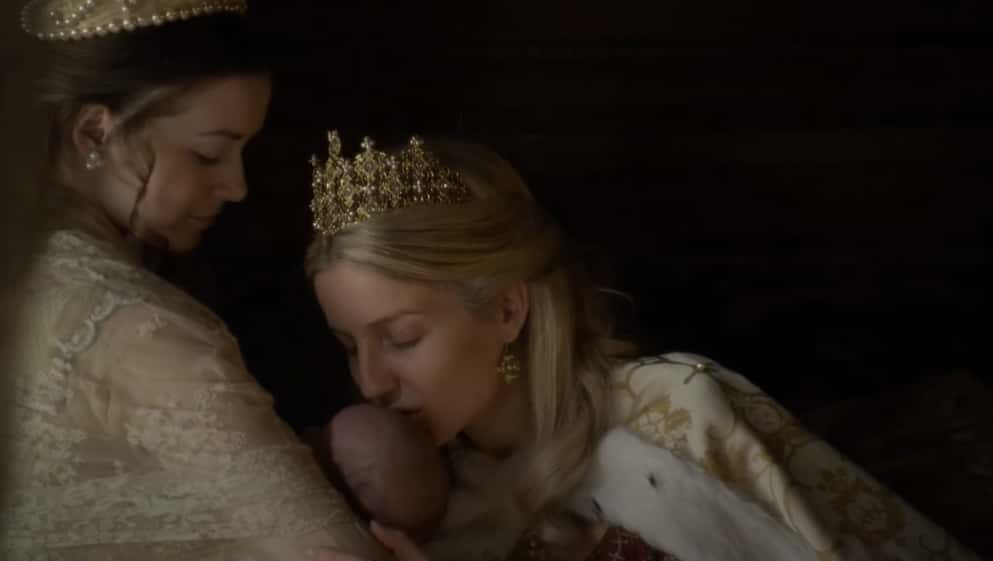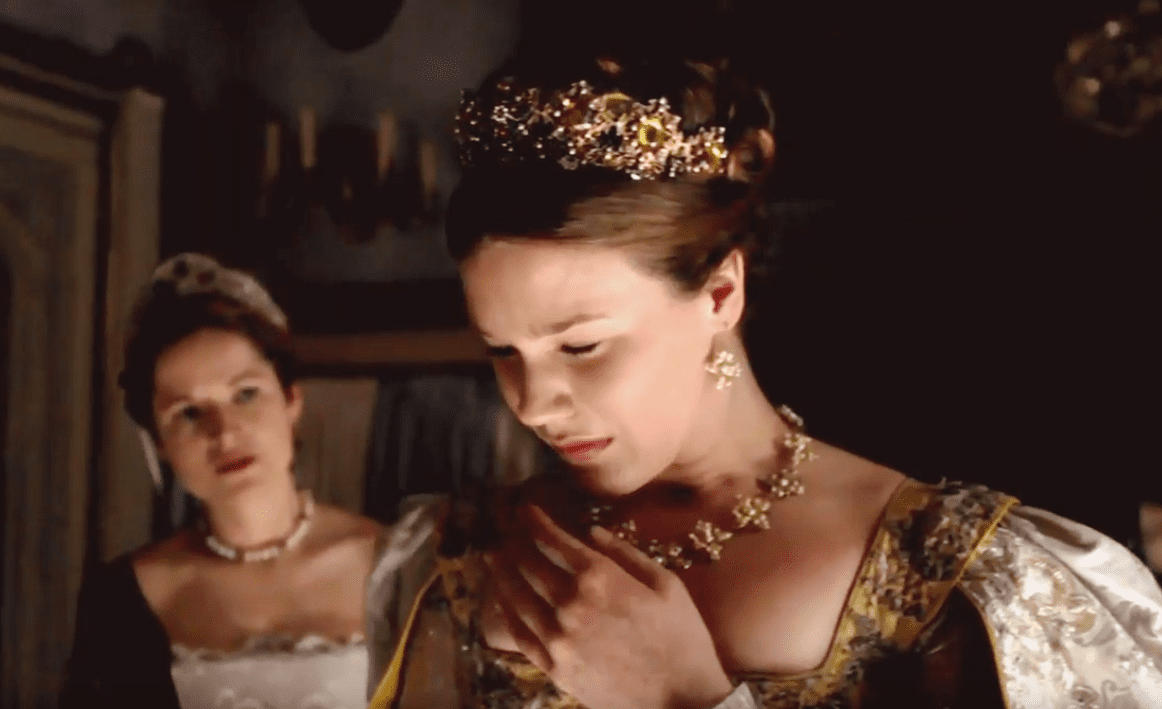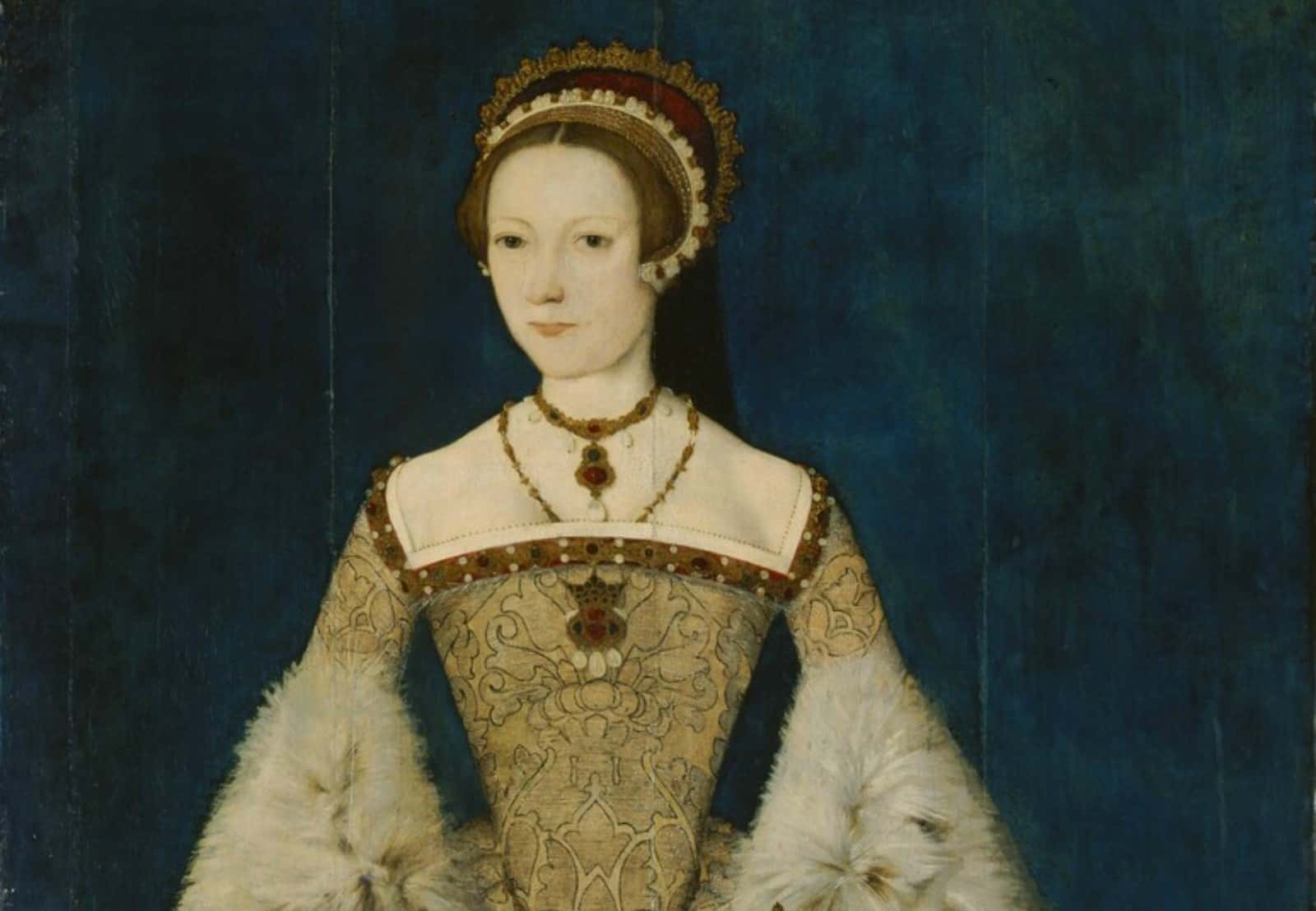“Good Christian people, I am come hither to be ended, for according to the law, and by the law I am judged to be ended, and therefore I will speak nothing against it. I am come hither to accuse no man, nor to speak anything of that, whereof I am accused and condemned to be ended".—Anne Boleyn.
Henry VIII is one of the most memorable kings in English history. He was the father of Elizabeth I and Mary I of England, and oversaw important historic events like the creation of the Church of England and England’s first journeys to the New World. But what everyone remembers about Henry is dude had, like, a bunch of wives. Six to be exact. One passed in childbirth. Two, he divorced. And two wound up with their heads chopped off. What can we say—it’s not easy being queen. Here are 42 tragic facts about the wives of Henry VIII.
1. The Spanish Princess
Henry VIII’s first wife was Catherine of Aragon. The daughter of Isabella I of Castile and Ferdinand II of Aragon—the Spanish monarchs who supported Christopher Columbus’s voyage—Catherine became queen of England in 1509 when she married Henry.

2. Hand-Me-Downs
Before she could marry Henry, however, Catherine was first married to Henry’s elder brother and heir apparent to the throne, Arthur. Catherine of Aragon was betrothed to Arthur when she was just three years old! Arthur passed of a mysterious “sweating sickness” shortly after their marriage, leaving Catherine a widow at just 16 years old.
 The Spanish Princess (2019– 2020), All3 Media
The Spanish Princess (2019– 2020), All3 Media
3. The Deal
Catherine’s marriage to Henry was very much a marriage of convenience. A substantial dowry of 200,000 crowns was owed to England if Catherine’s marriage to Arthur fell through. Unfortunately, Catherine’s mother, Queen Isabella,passed shortly after Arthur did, leaving Spain in a weak economic position. A compromise was reached where Catherine would be married to Henry, thereby canceling the debt. Catherine was deeply unhappy with this arrangement.
 The Spanish Princess (2019– 2020), All3 Media
The Spanish Princess (2019– 2020), All3 Media
4. The Ambassador
Catherine of Aragon married Henry in 1509. Between Arthur’s passing and her marriage to Henry, Catherine served Henry’s father—that’d be Henry VII—as the royal ambassador to Spain, making her the first female diplomat in European history.
 The Spanish Princess (2019– 2020), All3 Media
The Spanish Princess (2019– 2020), All3 Media
5. Teacher’s Pet
Catherine was a dedicated patron of the arts, and she encouraged the spread of Renaissance humanism. When Spanish scholar Juan Luis Vives wrote a book arguing that women had the right to an education, he dedicated it to Catherine.
6. Obsession
Henry was consumed by his desire to father a son—something that proved famously difficult for him. Catherine of Aragon bore Henry six children, including two sons, but all but one of those children—the future Queen Mary—passed in infancy. Henry and Catherine’s inability to produce offspring caused major problems in their marriage.
 The Tudors (2007–2010), Showtime Networks
The Tudors (2007–2010), Showtime Networks
7. Crisis of Faith
Henry thought he might have better luck with the whole male heir thing if he could try with a different, preferably, younger wife. There was just one problem: divorce was unacceptable within the Roman Catholic Church. Henry argued to church officials that his marriage was cursed because he married his brother’s wife—basically interbreeding. Catherine, however, insisted she and Arthur had never consummated the marriage, and the church continued to recognize Henry’s marriage as unbreakable. In response, Henry enacted a law which made him head of both church and state in England, effectively creating the Church of England.
8. The Great Defender
Ironically, Pope Leo X had declared Henry “Defender of the Faith” because of a treatise Henry wrote defending the Catholic position on marriage against the arguments of Protestant reformers. Henry was excommunicated, and his title of “Defender of the Faith” revoked. The British Parliament made up for that in 1844 by giving Henry a new title: “Defender of the Faith,” a title which holds absolutely no relation to the Catholic “Defender of the Faith,” but which continues to be applied to Britain’s reigning monarch.
9. In Her Own Right
For her own arguments against the Protestant Reformation, especially its views on marriage, Catherine of Aragon was herself named a Defender of the Faith in 1823.
 Flickr, Folger Shakespeare Library
Flickr, Folger Shakespeare Library

Sign up to our newsletter.
History’s most fascinating stories and darkest secrets, delivered to your inbox daily. Making distraction rewarding since 2017.
10. A House Divided
Henry’s treatment of Catherine of Aragon after the divorce caused a major rift between Henry and his daughter, Mary. To help curb Mary’s resentment, Henry forbid the mother and daughter from communicating, but sympathetic servants secretly carried letters back and forth between them.
 The Tudors (2007–2010), Showtime Networks
The Tudors (2007–2010), Showtime Networks
11. Begging to Get In
Catherine spent her final days as the image of Catholic piety. Though she had access to all of Kimbleton Castle, she remained in a single room, fasting and praying. Though she once said “I would rather be a poor beggar’s wife and be sure of Heaven than queen of all the world,” for the rest of her life, she continued to refer to herself as the Queen of England.
 The Tudors (2007–2010), Showtime Networks
The Tudors (2007–2010), Showtime Networks
12. The Record
In all, Catherine of Aragon remained married to Henry VIII for 24 years. Their marriage lasted longer than all of Henry’s other marriages combined.
13. My Bloody Valentine
In 1513, a heavily pregnant Catherine of Aragon rode in full armor to address her army at the Battle of Flodden. Henry was away at a foreign battle, leaving Catherine as regent. The Scottish army, led by Henry’s brother-in-law King James IV, took advantage of his absence and tried to attack the kingless nation. Catherine utterly destroyed the Scots and sent a bloody piece of James’s coat to Henry for use as a battle banner. She had wanted to send her hubby his brother-in-law’s body itself, but that was too much for those weak-bellied Englishmen—her words. Remember, this bloodshed was during their happy days!
 The Spanish Princess (2019– 2020), All3 Media
The Spanish Princess (2019– 2020), All3 Media
14. Greensleeves
Henry was a king, sure, but really that was just a job until his music career took off. By all accounts, Henry VIII was a gifted composer. According to one legend, Henry wrote the famous, anonymous “Greensleeves” to seduce the woman who would become his second wife, Anne Boleyn.
 The Other Boleyn Girl (2008), Focus Features
The Other Boleyn Girl (2008), Focus Features
15. Born For This
Anne Boleyn was the daughter of Thomas Boleyn, Earl of Ormond, and she had been groomed to be a society figure from an early age. Barely a teenager, Anne was shipped to France to serve in the court of her future brother-in-law, Louis XII. Anne quickly developed a thorough knowledge of French art and courtly custom, and her marriage to Henry VIII ushered in a brief French craze among English society.
 The Other Boleyn Girl (2008), Focus Features
The Other Boleyn Girl (2008), Focus Features
16. A Family Affair
It’s widely known that, before he married Anne Boleyn, Henry VIII carried out a long affair with Anne’s sister, Mary. Less famously—though more luridly—Henry was said to have also slept with Anne’s mother, Elizabeth.
 The Other Boleyn Girl (2008), Focus Features
The Other Boleyn Girl (2008), Focus Features
17. No Love Lost
Anne Boleyn showed no lack of disdain for her predecessor, Catherine of Aragon. She refused to attend Catherine’s funeral, prevented Catherine’s daughter Mary from attending, and spent the day parading around the castle in bright yellow. Rumors spread that Anne had threatened to ending Catherine and Mary, and Catherine’s passing led many to suggest that Anne had finally made good on her word.
18. Heart of Darkness
For its time, Catherine of Aragon’s cause of her end was ambiguous. Her embalmer noticed the body was in perfect health—save for her heart, which had turned black. That led some people to whisper about poison. Today, historians agree generally agree that Catherine passed from heart cancer, which—considering the circumstances of her life—appears too poetic to be true.
 The Tudors (2007–2010), Showtime Networks
The Tudors (2007–2010), Showtime Networks
19. The End Draws Nigh
Anne’s time with Henry would be short-lived. Despite getting pregnant several times, Anne only produced one child for Henry, Elizabeth. The final straw for the King came when Anne found Jane Seymour sitting on Henry’s lap and flew into a rage. He began looking for ways to break the marriage immediately.
 The Tudors (2007–2010), Showtime Networks
The Tudors (2007–2010), Showtime Networks
20. Close, but No Cigar
Prior to Elizabeth’s birth, both Henry and Anne were so certain of a male child—an astrologer had all but promised it—that the royal announcement had to be quickly, and sloppily, amended to read “princess” instead of “prince". The customary joust, planned for the day of a male heir’s birth, had to be canceled at the last minute.
 The Tudors (2007–2010), Showtime Networks
The Tudors (2007–2010), Showtime Networks
21. Mock Trial
No fewer than seven men were accused of carrying out affairs with Anne Boleyn, among them the poet Sir Thomas Wyatt, Henry’s friend Henry Norris, and Anne’s own brother, George. Virtually all denied the allegations or confessed under terror. Those coerced confessions were enough to have Anne condemned to her end for adultery, treason, and interbreeding. Modern historians agree that the charges brought against Anne Boleyn that led to her execution were false and unconvincing and that Henry had her ended just because she didn’t happen to have any male children.
 The Other Boleyn Girl (2008), Focus Features
The Other Boleyn Girl (2008), Focus Features
22. The Poet
As she awaited her execution in the Tower of London, Anne Boleyn wrote a poem called “O De*th, Rock Me Asleep".
 The Tudors (2007–2010), Showtime Networks
The Tudors (2007–2010), Showtime Networks
23. High Spirits
Anne Boleyn was beheaded on May 19, 1536. She went to the block with surprisingly high spirits, cracking jokes about the length of her neck and referring to herself as “Lady Anne Lack-Head". When Anne was brought to the scaffold to be ended, she begged leave to address the crown and was granted the right to do so. Despite the limited evidence against her, she said, “Good Christian people, I am come hither to be ended, for according to the law, and by the law, I am judged to be ended, and therefore I will speak nothing against it. I am come hither to accuse no man, nor to speak anything of that, whereof I am accused and condemned to end, but I pray God save the king and send him long to reign over you, for a gentler nor a more merciful prince was there never: and to me he was ever a good, a gentle and sovereign lord. And if any person will meddle of my cause, I require them to judge the best. And thus I take my leave of the world and of you all, and I heartily desire you all to pray for me. O Lord have mercy on me, to God I commend my soul".
As she awaited the executioner’s blade, kneeling on the block, she repeated the phrase, “To Jesus Christ I commend my soul; Lord Jesu receive my soul".
 The Other Boleyn Girl (2008), Focus Features
The Other Boleyn Girl (2008), Focus Features
24. Is it Her?
Despite the careful planning that went into Anne Boleyn’s execution, little to no thought was given to what should be done with her remains afterward. Not having arranged for a coffin, her remains were allegedly put into an old arrow chest, and she and her brother were buried in an unmarked grave in front of the altar at the Church of St. Peter ad Vincula. In an interesting twist, it turned out that five other beheaded women had been buried under the altar, and it had simply been assumed that the bones found in an arrow chest there were hers. There is also a theory that her relatives had her body secretly reburied somewhere else, which based on that discovery, might have been true. Without DNA testing, the truth will probably never be known.
 Wikimedia Commons, Michael Coppins
Wikimedia Commons, Michael Coppins
25. No Lava Lost
As one of the most powerful and famous women in the world, Boleyn’s execution made headlines around Europe. The story captured the imaginations of common people even in distant Sicily. The devout villagers of Nicolosi, for example, came to believe that, for her role in Henry’s excommunication, Anne Boleyn had been condemned to volcanic fires of Mount Etna.
26. All Her Old Haunts
Others have seen Anne much closer to home. Her ghost has been spotted in several places around England, including the Tower of London, Marwell Hall, and her childhood home, Hever Castle.  Wikipedia
Wikipedia
27. That Didn’t Take Long
The day after Anne Boleyn’s beheading, Henry got engaged to Jane Seymour, Anne Boleyn’s lady in waiting. While she was publicly proclaimed queen, her coronation never went ahead due to an outbreak of plague.
 The Tudors (2007–2010), Showtime Networks
The Tudors (2007–2010), Showtime Networks
28. Frenemies
Jane was not only Anne Boleyn’s lady in waiting, she was also Anne’s second cousin. The two women had been close friends at Henry’s court until Anne noticed the necklace Jane wore. The necklace featured a small portrait of Jane’s lover—Henry VIII. Anne angrily snatched the necklace from Jane’s hand, leading to what modern witnesses would probably describe as a “catfight".
 The Tudors (2007–2010), Showtime Networks
The Tudors (2007–2010), Showtime Networks
29. The One?
In 1537, to Henry’s great relief, Jane became pregnant with a son. Sadly, Jane Seymour lost her life from complications shortly after giving birth to the future Edward VI. She remained the only one of Henry’s wives to be given a royal burial, and Henry was buried beside her upon his passing in 1547. The question now remains: was she the one, or was it the son?
 The Tudors (2007–2010), Showtime Networks
The Tudors (2007–2010), Showtime Networks
30. Which One?
King Henry VIII was a pretty heartless idiot, and as much as people have romanticized his great love for Jane, having a son and heir was always his number one priority. Jane’s labor was difficult, and when asked by a female attendant whether he wanted to save the mother or child if it came down to it, he supposedly replied “If you cannot save both, at least let the child live," followed by the characteristic statement "for other wives are easily found". Priorities, right?
 The Tudors (2007–2010), Showtime Networks
The Tudors (2007–2010), Showtime Networks
31. How Shallow
Ever been on a Tinder date with someone who looks nothing like their profile pic? Henry VIII feels your pain. He saw a commissioned portrait of Anne of Cleves and was smitten. He didn’t meet her face to face until after the marriage had been arranged and later complained to a friend, “She is nothing so fair as she hath been reported".
 The Tudors (2007–2010), Showtime Networks
The Tudors (2007–2010), Showtime Networks
32. No Hard Feelings
Henry’s marriage to Anne was quickly annulled—a process made much easier by Anne’s claim that the marriage was never consummated. Whether that was true or not, Henry gave Anne two houses and an allowance for her cooperation, and she would go on to live the longest of any of Henry’s wives.
 The Tudors (2007–2010), Showtime Networks
The Tudors (2007–2010), Showtime Networks
33. It Runs in the Family
After Anne of Cleves comes Catherine Howard. A cousin of Anne Boleyn, Catherine Howard remained married to Henry VIII little more than a year before her passing. Like her cousin before her, Catherine Howard was sentenced to be beheaded.
 The Tudors (2007–2010), Showtime Networks
The Tudors (2007–2010), Showtime Networks
34. Playing House
The marriage to Henry was Catherine Howard’s second—sort of. While serving as an attendant to the Dowager Duchess of Norfolk, Catherine entered into a relationship with Francis Dereham, a secretary to the Dowager Duchess. The two even referred to each other as husband and wife and seemed to have an agreement to formally marry, but when the Dowager Duchess found out, she put an end to the relationship.
35. Another “Divorce”
Catherine Howard disavowed any relationship with Francis Dereham, but a blatant affair with one of Henry’s favorite courtiers, Thomas Culpepper, proved her downfall. Both Dereham and Culpepper were executed for treason, and Catherine herself was stripped of her crown and condemned to be ended.
 The Tudors (2007–2010), Showtime Networks
The Tudors (2007–2010), Showtime Networks
36. No Regrets
Catherine was executed on February 13, 1542. Unlike her cousin, Anne Boleyn, Catherine Howard remained indignant to the very end. Her last words, supposedly, were “I meet my end as a queen, but would rather have meet my end as the wife of a Culpepper". How…sweet?
 The Tudors (2007–2010), Showtime Networks
The Tudors (2007–2010), Showtime Networks
37. Wife Number Six
Twice-widowed Catherine Parr married Henry VIII on July 12, 1543. 21 years Henry’s junior, Catherine Parr was actually named after Henry’s first wife, Catherine of Aragon, to whom Catherine’s mother had been a lady-in-waiting.
 The Tudors (2007–2010), Showtime Networks
The Tudors (2007–2010), Showtime Networks
38. Lovers’ Quarrels
Unlike Henry, who despite his excommunication, still held some Catholic beliefs, Catherine Parr was sympathetic to the idea of reform. She and Henry had great, heated debates about religion; these debates would become a point of concern among Henry’s advisors, who felt disagreement with Henry over religious matters was tantamount to treason.
39. Most Wanted
In 1546, a member of Henry’s Lord Chancellor, Henry Wriothesley, detained, tortured, and executed Protestant reformer Anne Askew. Among those named by Askew were some of Catherine Parr’s closes friends and confidants. Wriothesley issued a warrant for Catherine’s arrest on the grounds of treason.
40. A Change of Heart
Rather than defend his wife, Henry cooperated with Wriothesley, even attempting to trick her into committing heresy. Catherine, who had been tipped off to this ambush by one of her servants, walked back her opinions, saying she only argued with Henry to distract him from the pain of his ulcers. Henry so readily forgave his wife that, when Wriothesley arrived to arrest Catherine, Henry attack the Lord Chancellor.
 The Tudors (2007–2010), Showtime Networks
The Tudors (2007–2010), Showtime Networks
41. A Royal Success
Despite Catherine’s disagreements with Henry over matters of religion, she still had a tremendous influence on royal policy. Sympathetic to the situation of Henry’s eldest daughters, Mary and Elizabeth, Catherine effected a reconciliation between the girls and their father and convinced Henry to pass the Third Succession Act, which formally declared that, in the event of Edward’s passing, succession would follow through them.
 The Tudors (2007–2010), Showtime Networks
The Tudors (2007–2010), Showtime Networks
42. Olden Times Bestsellers
Catherine Parr wrote three books while married to Henry. Her first, Psalms or Prayers, was published anonymously. She published Prayers and Meditations under her own name, making it the first book officially published by a sitting queen of England. Her third and final book, The Lamentation of a Sinner, was written in 1546, but not released until after Henry’s passing.
43. So They Had That In Common
Before marrying Henry VIII, Catherine Parr was married first to Sir Edwin Burgh and then to Sir Neville, 3rd Baron Latimer. After Henry’s passing, Catherine married a fourth time, to Thomas Seymour, brother of Henry’s third wife, Jane Seymour. Catherine and Thomas remained married until she passed. All told, Catherine had more husbands than Henry had wives.
44. Clean Slate
“But didn’t you say Henry had, like, half a dozen wives?” Yes. Technically, Henry VIII married a total of six times, but only three of those marriages were considered legally valid. His marriages to Catherine of Aragon, Anne Boleyn, and Anne of Cleves were annulled, meaning that they essentially never happened.
 The Tudors (2007–2010), Showtime Networks
The Tudors (2007–2010), Showtime Networks
45. The Lion’s Share
Nearly 15% of all consorts to the English throne, dating all the way back to 1066, were married to Henry VIII.
 The Tudors (2007–2010), Showtime Networks
The Tudors (2007–2010), Showtime Networks
46. Common Denominator
Considering all the trouble Henry’s wives and mistresses had giving him a son, sooner or later you’ve got to think the problem is Henry himself, right? That might be the case. Some researchers now suspect Henry VIII’s royal blood carried the Kell antigen, which can lead not only to reproductive issues, but also to many of the physical and mental ailments which plagued Henry later in his life.
 The Tudors (2007–2010), Showtime Networks
The Tudors (2007–2010), Showtime Networks
Sources: 1, 2, 3, 4, 5, 6, 7, 8, 9, 10, 11, 12, 13, 14, 15, 16, 17, 18, 19, 20, 21, 22





















